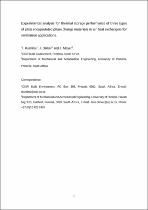 ResearchSpace
ResearchSpace
Experimental analysis for thermal storage performance of three types of plate encapsulated phase change materials in air heat exchangers for ventilation applications
JavaScript is disabled for your browser. Some features of this site may not work without it.
- ResearchSpace
- →
- Research Publications/Outputs
- →
- Journal Articles
- →
- View Item
| dc.contributor.author |
Kumirai, Tichaona

|
|
| dc.contributor.author |
Dirker, J

|
|
| dc.contributor.author |
Meyer, J

|
|
| dc.date.accessioned | 2019-03-23T13:37:21Z | |
| dc.date.available | 2019-03-23T13:37:21Z | |
| dc.date.issued | 2019-03 | |
| dc.identifier.citation | Kumirai, T., Dirker, J. and Meyer, J. 2019. Experimental analysis for thermal storage performance of three types of plate encapsulated phase change materials in air heat exchangers for ventilation applications. Journal of Building Engineering, vol. 22: 75-89 | en_US |
| dc.identifier.issn | 2352-7102 | |
| dc.identifier.uri | https://www.sciencedirect.com/science/article/pii/S2352710218309033 | |
| dc.identifier.uri | https://doi.org/10.1016/j.jobe.2018.11.016 | |
| dc.identifier.uri | http://hdl.handle.net/10204/10833 | |
| dc.description | Copyright: 2018 Elsevier. Due to copyright restrictions, the attached PDF file contains the preprint version of the published item. For access to the published article, please consult the publisher's website: https://www.sciencedirect.com/science/article/pii/S2352710218309033 | en_US |
| dc.description.abstract | Due to climate change and rising global temperatures, energy demand associated with commercial and office building cooling, is projected to increase. Passive-cooling, based on phase change materials, can assist to moderate this increase, however relatively few modelling equations to describe its operating behaviour exists. In this experimental investigation the melting performance of three commercially available encapsulated phase change materials were evaluated for passive cooling applications in air ducts systems. Two paraffin type phase change materials and one salt hydrate phase change material with melting temperatures in the range of 22 °C and 28 °C were considered. Vertical orientated plate type encapsulations with a thickness of 10 mm and a pitch of 15 mm were tested for air inlet temperatures ranging from 30 °C to 35 °C and upstream air velocities ranging from 0.4 m/s and 0.9 m/s. The average effectiveness, cooling power, energy absorption, and phase transformation durations were determined. It was found that the average thermal effectiveness decreased with increased velocities and that the cooling power, which was inversely proportional to the phase transformation duration, increased with air flow rate and inlet air temperature. Based on the data a new empirical correlation model was developed which describes the cooling capacity of the in-duct phase change material plates. | en_US |
| dc.language.iso | en | en_US |
| dc.publisher | Elsevier | en_US |
| dc.relation.ispartofseries | Worklist;21905 | |
| dc.subject | Phase change materials | en_US |
| dc.subject | Cooling power | en_US |
| dc.subject | Energy storage | en_US |
| dc.subject | Phase transformation duration | en_US |
| dc.title | Experimental analysis for thermal storage performance of three types of plate encapsulated phase change materials in air heat exchangers for ventilation applications | en_US |
| dc.type | Article | en_US |
| dc.identifier.apacitation | Kumirai, T., Dirker, J., & Meyer, J. (2019). Experimental analysis for thermal storage performance of three types of plate encapsulated phase change materials in air heat exchangers for ventilation applications. http://hdl.handle.net/10204/10833 | en_ZA |
| dc.identifier.chicagocitation | Kumirai, Tichaona, J Dirker, and J Meyer "Experimental analysis for thermal storage performance of three types of plate encapsulated phase change materials in air heat exchangers for ventilation applications." (2019) http://hdl.handle.net/10204/10833 | en_ZA |
| dc.identifier.vancouvercitation | Kumirai T, Dirker J, Meyer J. Experimental analysis for thermal storage performance of three types of plate encapsulated phase change materials in air heat exchangers for ventilation applications. 2019; http://hdl.handle.net/10204/10833. | en_ZA |
| dc.identifier.ris | TY - Article AU - Kumirai, Tichaona AU - Dirker, J AU - Meyer, J AB - Due to climate change and rising global temperatures, energy demand associated with commercial and office building cooling, is projected to increase. Passive-cooling, based on phase change materials, can assist to moderate this increase, however relatively few modelling equations to describe its operating behaviour exists. In this experimental investigation the melting performance of three commercially available encapsulated phase change materials were evaluated for passive cooling applications in air ducts systems. Two paraffin type phase change materials and one salt hydrate phase change material with melting temperatures in the range of 22 °C and 28 °C were considered. Vertical orientated plate type encapsulations with a thickness of 10 mm and a pitch of 15 mm were tested for air inlet temperatures ranging from 30 °C to 35 °C and upstream air velocities ranging from 0.4 m/s and 0.9 m/s. The average effectiveness, cooling power, energy absorption, and phase transformation durations were determined. It was found that the average thermal effectiveness decreased with increased velocities and that the cooling power, which was inversely proportional to the phase transformation duration, increased with air flow rate and inlet air temperature. Based on the data a new empirical correlation model was developed which describes the cooling capacity of the in-duct phase change material plates. DA - 2019-03 DB - ResearchSpace DP - CSIR KW - Phase change materials KW - Cooling power KW - Energy storage KW - Phase transformation duration LK - https://researchspace.csir.co.za PY - 2019 SM - 2352-7102 T1 - Experimental analysis for thermal storage performance of three types of plate encapsulated phase change materials in air heat exchangers for ventilation applications TI - Experimental analysis for thermal storage performance of three types of plate encapsulated phase change materials in air heat exchangers for ventilation applications UR - http://hdl.handle.net/10204/10833 ER - | en_ZA |





